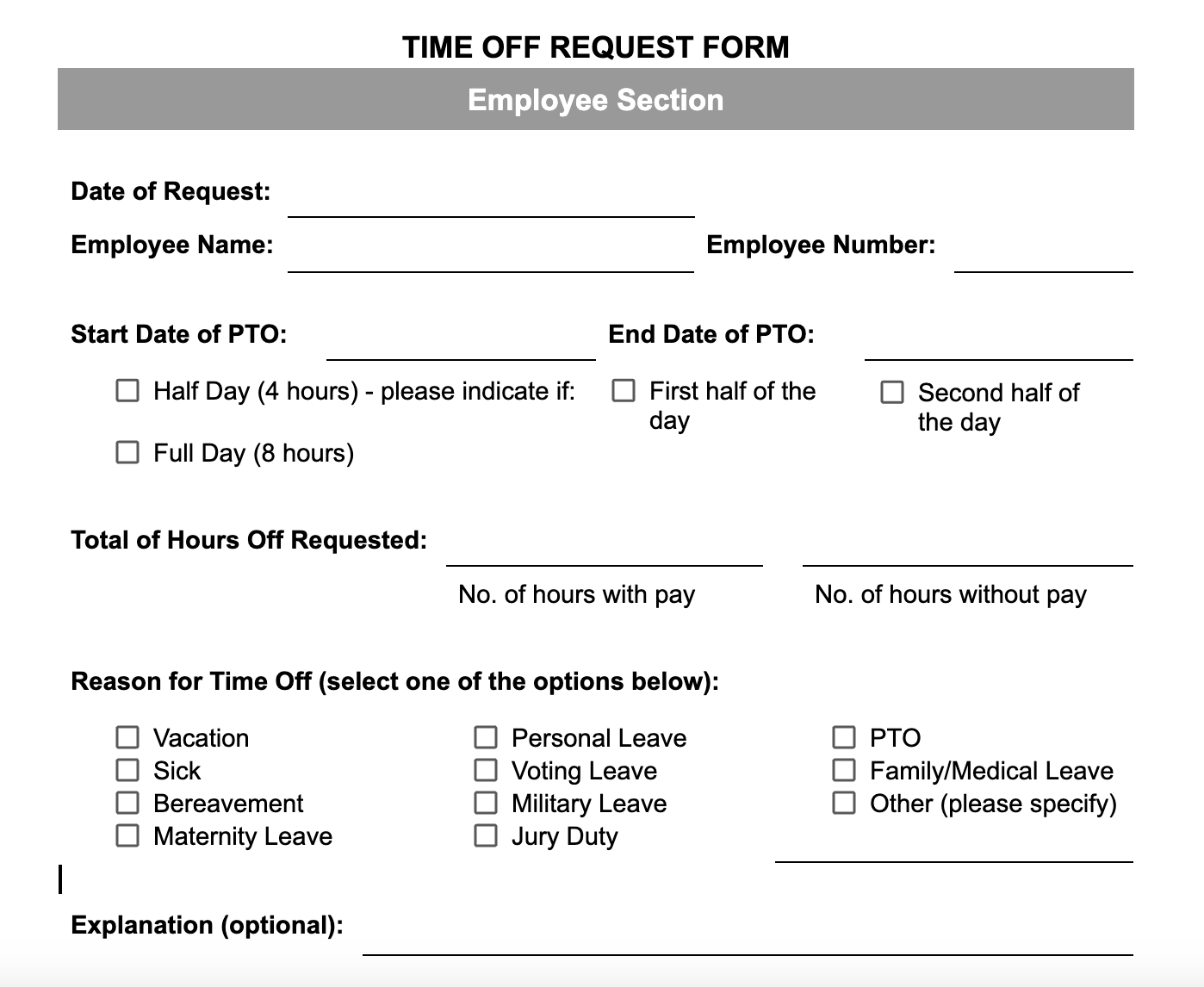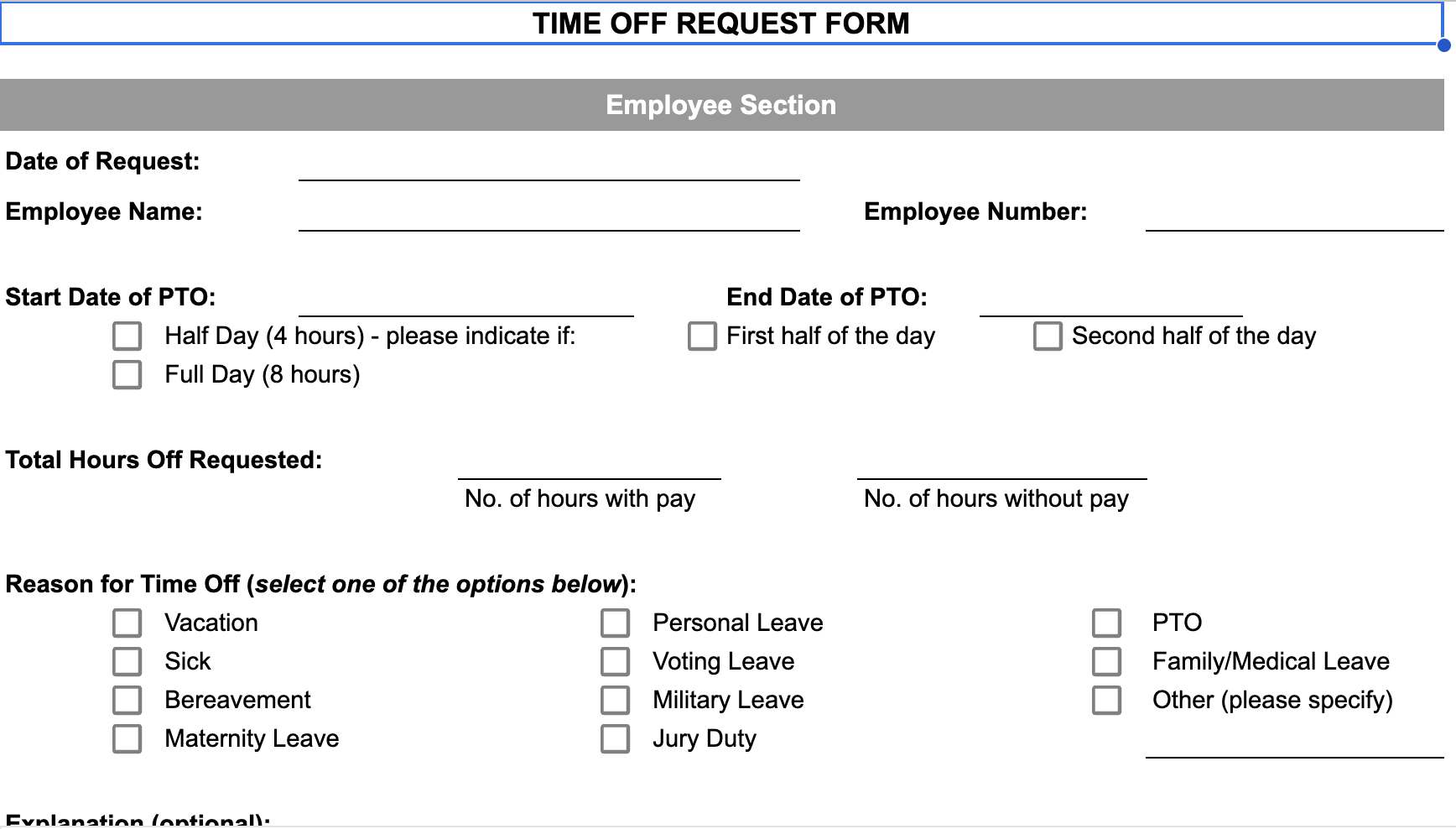Before you allow your employees to take any kind of leave, have them fill out a time off request form. Your paid time off (PTO) request, or vacation request form, should document the reason and duration of your employees’ time away from work, when the request was made, and who approved it. Using a standardized form not only streamlines staff scheduling but also ensures clear communication and compliance with workplace policies.
Our free employee time off request form can be tailored to your company’s needs — simply add your company name, logo, and any additional fields necessary. Download the form in Word, Excel, Google Docs, and Google Sheets for easy customization.
If you want to ditch the paper forms and track employee time off in the most efficient way possible, consider using time and attendance software, such as Homebase. It supports online PTO requests and approvals and lets you create time-off policies to automatically track leave accruals and balances. To learn more, read our Homebase review or visit its website.
Featured Partner
What to include in your time off request form
If you’re creating your own PTO request form, there are a few required fields to include that the requesting employee needs to fill out for proper record-keeping. The minimum requirements are the following:
- Name/ID number: This is needed to identify which employee is submitting the request, whether for auditing purposes or to maintain the employee’s leave balances.
- Date of request: This is the date when the employee requested time off. PTO approvers like supervisors and people managers can use this to prioritize which requests to accept. It is also beneficial if your time-off policy requires employees to submit their requests in advance.
- Date(s) of PTO: Include data fields to capture the beginning and ending dates of PTO. In addition to helping you decide how to schedule employees given the requested time off day(s), this allows you to keep tabs on any leave that is dependent on how many days an employee has already taken off (e.g., disability leave).
- Half day or full day: Have your employees check the box for whether they are taking a half day off or a full day. This information is dependent upon your policy rules and if you allow half days.
- Total hours off requested: To ensure accurate tracking, have employees specify the total working hours for their time off. This will be helpful, especially if their PTO spans several days or a weekend. If you allow them to request unpaid leave, add fields for employees to detail the number of unpaid hours.
- Reason: Tracking why employees take time off is needed for reporting purposes and maintaining accurate leave balances based on your PTO policy. The common options or leave types include vacation, sick, jury duty, military, bereavement, and family/medical, such as maternity, if your company has a maternity leave policy.
- Explanation (optional): Leave a space for your employees to explain the type of leave they are requesting. However, this should be listed as optional only — requiring an employee to explain certain types of leave could be a violation of certain laws and could be considered discriminatory.
- Signatures: This field is to ensure that all necessary parties are aware of the request and are in agreement for leaves that require a supervisor’s approval.
For more ideas and resources to help you monitor work hours, read our guide on ways to track employee time. If you need a tool to manually capture staff attendance, check out our employee attendance tracker article, which contains a template you can download for free.
Reasons to track employee time off
Using a paid time off request form to track employee PTO requests is essential for several reasons, such as:
- Compliance with labor laws: Some employee leaves include paid sick days, which are mandated by certain state laws (see our paid sick leave laws by state guide). Other leave types are covered by the Family and Medical Leave Act (FMLA). Properly documenting these time-off transactions is crucial, helping you avoid potential fees and penalties for non-compliance.
- Avoid scheduling conflicts: Many people managers and supervisors need to plan work schedules to efficiently manage employees and ensure that the company has adequate coverage if team members in their department are taking time off. A time off request template makes it easier to monitor who will be out and when, especially if some work may need to be reallocated because of an employee’s absence.
- Consistent application of company polices: A standardized time off or vacation request form lets you apply your company’s PTO policies fairly across all employees. In addition to ensuring consistency, it will help you avoid favoritism, misunderstandings, and potential disputes.
Best practices for managing time off requests
Effective management of time-off requests is essential for maintaining a productive and compliant workplace. While using a time off request form can help track employee PTO days, here are other best practices to consider:
- Establish clear policies: Create a PTO policy that clearly outlines the types of leave available, when each should be used, and how to apply for each type. Don’t forget to mention who will approve the request and how decisions will be communicated, especially when a time off request is denied or can’t be accommodated.
- Identify submission timelines: Specify how far in advance time off requests must be submitted. For planned vacation days and scheduled appointments, such as scheduled surgeries, the standard advance notice is one week to one month. Sick days and emergencies require prompt notification, although some paid sick leave state laws require notice “as soon as practicable.”
- Plan for overlapping requests: To prevent staffing shortages, review PTO requests as they come in and approve them based on business needs. Having a first-come, first-served rule or a priority system can help manage overlapping requests fairly.
- Set blackout periods: Identify important dates when employee time off isn’t allowed except for emergencies, illness, or bereavement. This approach is valuable for businesses with busy seasons, such as manufacturing companies, retail shops, and restaurants.
- Choose the right record-keeping system: There are two ways to manage time off request forms: manual tracking and digital systems. However, each has its benefits and drawbacks.
Looking for online software to simplify PTO and employee time tracking? Check out our best time and attendance software guide.
Time off request form frequently asked questions (FAQs)
Paper copies of time off request forms should be kept in individual employee personnel files. If you collect your requests digitally, you can create a folder for each employee to store them online.
In the US, there isn’t a legal or federal regulation that limits the number of times employees can submit a time off request. If you want to avoid workers requesting PTO too often, include a rule in your company policy that specifies the number of time-off requests that can be submitted monthly.
The appropriate number of time off days to request depends on your company’s PTO policy, operational needs, and the type of leave (e.g., maternity leave or prolonged leave due to sickness). Generally, requesting more than two consecutive weeks at once may be considered excessive in most workplaces, especially if it falls during busy periods and creates significant manpower coverage issues.







